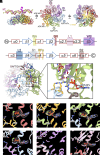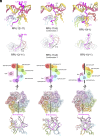Subunit specialization in AAA+ proteins and substrate unfolding during transcription complex remodeling
- PMID: 40273105
- PMCID: PMC12054792
- DOI: 10.1073/pnas.2425868122
Subunit specialization in AAA+ proteins and substrate unfolding during transcription complex remodeling
Erratum in
-
Correction for Gao et al., Subunit specialization in AAA+ proteins and substrate unfolding during transcription complex remodeling.Proc Natl Acad Sci U S A. 2025 Jul 29;122(30):e2516674122. doi: 10.1073/pnas.2516674122. Epub 2025 Jul 21. Proc Natl Acad Sci U S A. 2025. PMID: 40690681 Free PMC article. No abstract available.
Abstract
Bacterial RNA polymerase (RNAP) is a multisubunit enzyme that copies DNA into RNA in a process known as transcription. Bacteria use σ factors to recruit RNAP to promoter regions of genes that need to be transcribed, with 60% bacteria containing at least one specialized σ factor, σ54. σ54 recruits RNAP to promoters of genes associated with stress responses and forms a stable closed complex that does not spontaneously isomerize to the open state where promoter DNA is melted out and competent for transcription. The σ54-mediated open complex formation requires specific AAA+ proteins (
Keywords: AAA+ ATPases; DNA opening; RNA polymerase; protein unfolding and remodeling; transcription initiation.
Conflict of interest statement
Competing interests statement:The authors declare no competing interest.
Figures





Similar articles
-
Bacterial Enhancer Binding Proteins-AAA+ Proteins in Transcription Activation.Biomolecules. 2020 Feb 25;10(3):351. doi: 10.3390/biom10030351. Biomolecules. 2020. PMID: 32106553 Free PMC article. Review.
-
Real-time capture of σN transcription initiation intermediates reveals mechanism of ATPase-driven activation by limited unfolding.Nat Commun. 2025 Aug 4;16(1):7138. doi: 10.1038/s41467-025-61837-4. Nat Commun. 2025. PMID: 40759887 Free PMC article.
-
Characterization of a transitionally occupied state and thermal unfolding of domain 1.1 of factor of RNA polymerase from Bacillus subtilis.Proteins. 2023 Sep;91(9):1276-1287. doi: 10.1002/prot.26531. Epub 2023 Jun 22. Proteins. 2023. PMID: 37350110
-
Late gene regulation by the alternative sigma factors of Chlamydia trachomatis.mSystems. 2025 Jul 22;10(7):e0029225. doi: 10.1128/msystems.00292-25. Epub 2025 Jun 12. mSystems. 2025. PMID: 40503901 Free PMC article.
-
Mechanisms for activating bacterial RNA polymerase.FEMS Microbiol Rev. 2010 Sep;34(5):611-27. doi: 10.1111/j.1574-6976.2010.00239.x. Epub 2010 Jun 7. FEMS Microbiol Rev. 2010. PMID: 20629756 Review.
References
MeSH terms
Substances
Grants and funding
LinkOut - more resources
Full Text Sources

